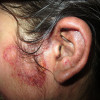
 IJCP Editorial Team
IJCP Editorial Team
Bilateral blurry vision in a 9-year-old boy
A report describes a case of a 9-year-old boy with no significant medical history who complained of painless blurry vision for two days. He also had dizziness and a mild frontal headache and denied any recent trauma or illness. His vision changes started at school and worsened the next day, allowing him to see only the outlines and shapes of objects.
On examination, his vital were within normal limits. Still, he struggled to distinguish shapes or count fingers on visual field testing, thus was consulted with an ophthalmologist, who noted bilateral optic disc swelling on fundoscopy.
Initial work-up showed a mildly elevated erythrocyte sedimentation rate and C-reactive protein, with unremarkable complete blood cell count and basic metabolic results.
Brain MRI showed abnormal thickening and enhancement of the optic nerves with bilateral papilledema. He had normal magnetic resonance venography. Follow-up orbital MRI confirmed bilateral optic neuritis.
MRI spine showed no irregularities.
Lumbar puncture showed regular opening pressure and mild pleocytosis. The remaining cerebrospinal fluid (CSF) studies were unremarkable, including the absence of oligoclonal bands. He was negative for any infectious studies (HIV, syphilis, varicella, interferon γ-release assay, herpes simplex virus 1/2 plasma polymerase chain reaction, Lyme reflex) and rheumatologic studies (antinuclear antibodies, antineutrophil cytoplasmic antibodies).
The patient showed positive serum MOG antibody and negative AQP4, suggesting myelin oligodendrocyte glycoprotein antibody disease (MOG-AD) as the underlying cause of his bilateral optic neuritis.
He was given pulse-dose IV corticosteroids and underwent plasma exchange (PLEX) 5 times over ten days. His Visual acuity advanced from perceiving only hand motions at admission to 20/100 and 20/200 in the right and left eyes, respectively, upon discharge. Fundoscopy showed residual optic disc edema and temporal pallor.
The patient continued taking oral prednisone with a slow taper over several months. His visual acuity gradually improved to 20/40 and 20/30 in the right and left eye, respectively, but initial optic disc swelling led to permanent atrophy and thinning of his optic nerves.
Further, the patient developed multiple Cushingoid features causing a more aggressive prednisone tapering and initiating maintenance immunosuppression with mycophenolate mofetil. Lifelong suppression might not be essential in this case in the absence of future relapses.
Zero O, Lorenz ML. Bilateral blurry vision in a 9-year-old boy. Contemporary pediatrics. July 29, 2022. https://www.contemporarypediatrics.com/view/bilateral-blurry-vision-in-a-9-year-old-boy

IJCP Editorial Team
Comprising seasoned professionals and experts from the medical field, the IJCP editorial team is dedicated to delivering timely and accurate content and thriving to provide attention-grabbing information for the readers. What sets them apart are their diverse expertise, spanning academia, research, and clinical practice, and their dedication to upholding the highest standards of quality and integrity. With a wealth of experience and a commitment to excellence, the IJCP editorial team strives to provide valuable perspectives, the latest trends, and in-depth analyses across various medical domains, all in a way that keeps you interested and engaged.











Please login to comment on this article